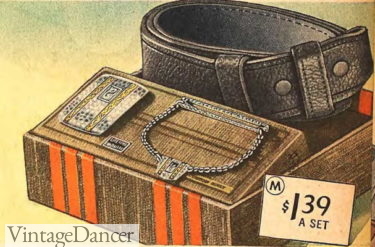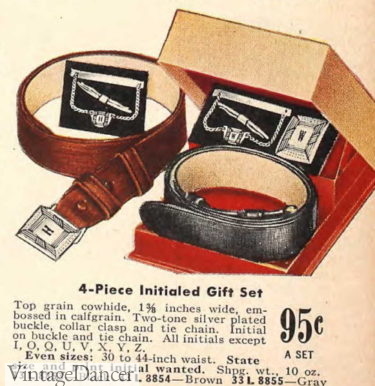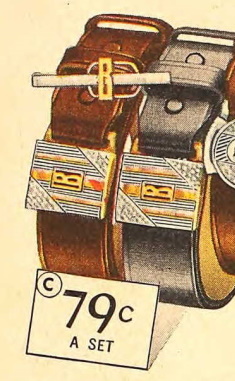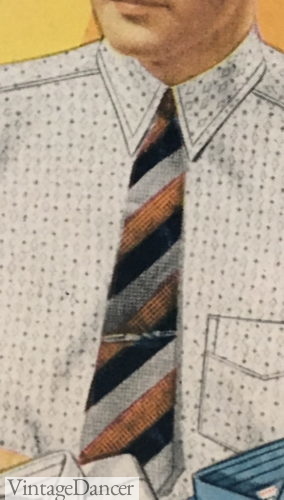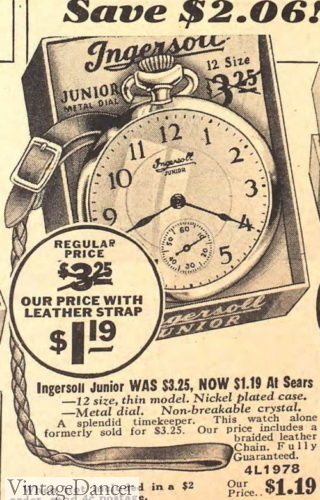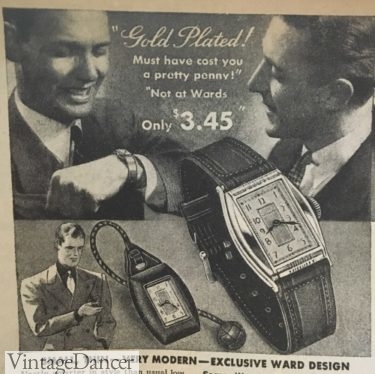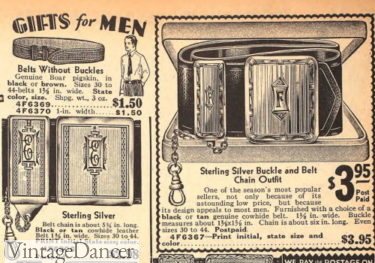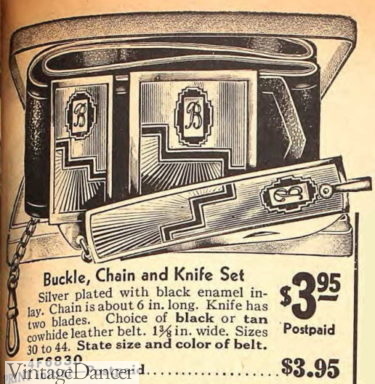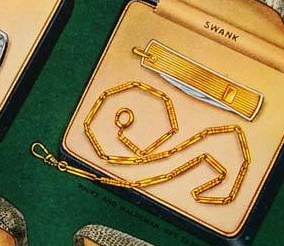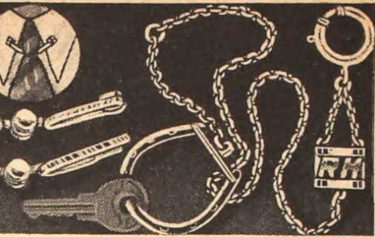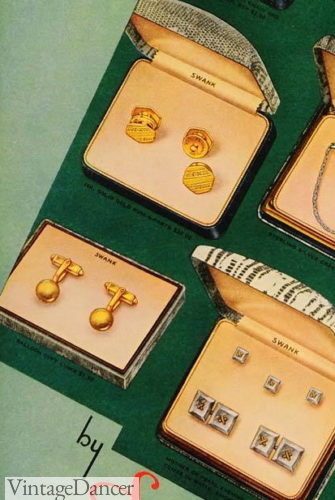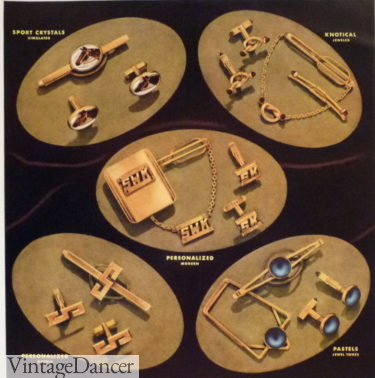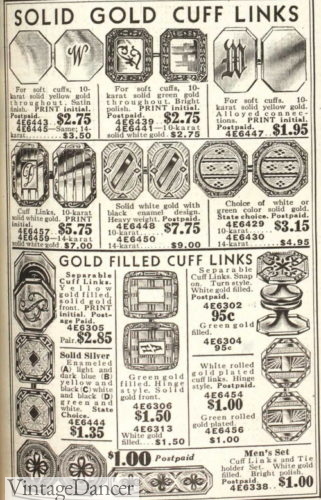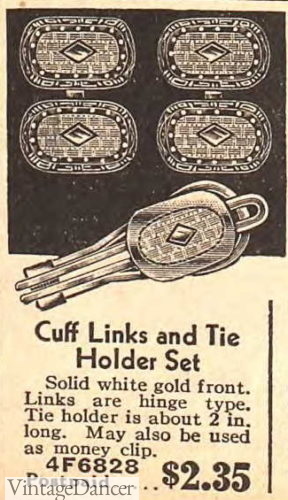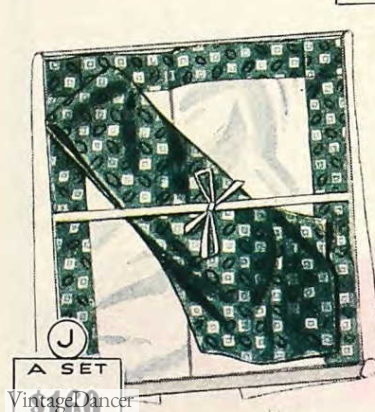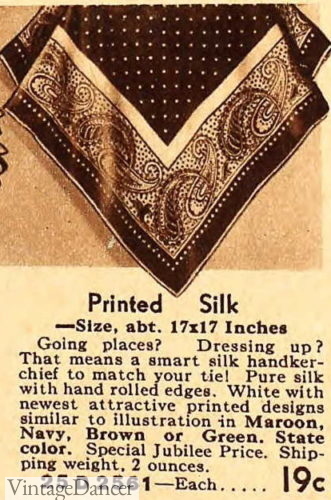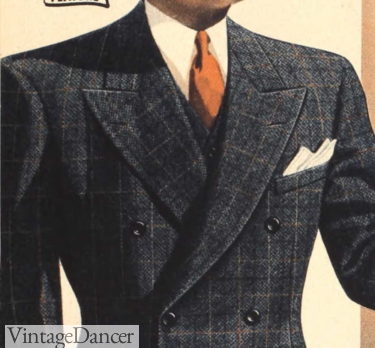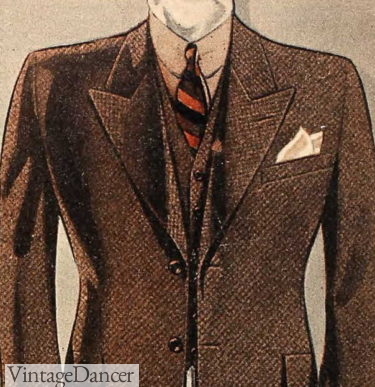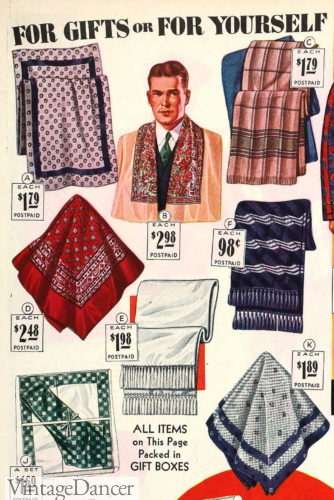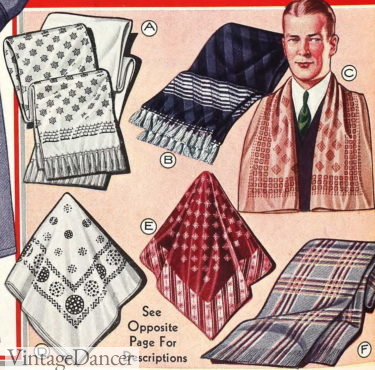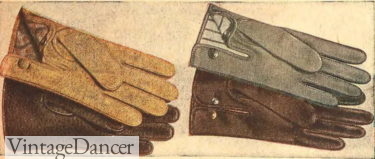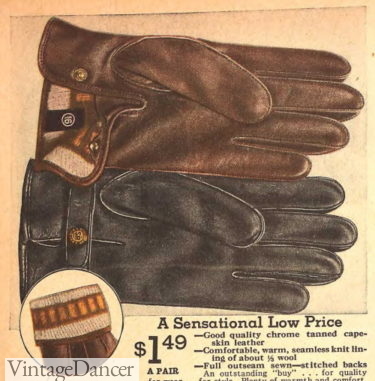The 1930s men’s accessories include:
- Suspenders
- Belts
- Jewelry for ties and collars
- Watches/ Pocket Watches
- Cufflinks
- Rings
- Pocket Square/ Handkerchief
- Muffler Scarves
- Gloves
- Bags
- more accessories
Continue reading to learn more about how men accessorized their outfit with both necessary and optional embellishments.
1930s Men’s Suspenders
Because of the high rise of trousers and looser fit, suspenders were critical pieces to a man’s wardrobe. Without them pants would be falling down. While it was against etiquette to have suspenders showing, they were colorful and flashy accessories anyways.
The newest news in men’s suspenders fashion was the use of elastic webbing. The naysayers didn’t like the limited color choices but most men preferred the stretch comfort that webbing provided.
Most elastic webbing was striped in white and solid colors-blue, maroon, brown and black. Closer to the 1940s there were some new webbing designs such as diamonds and medallions.
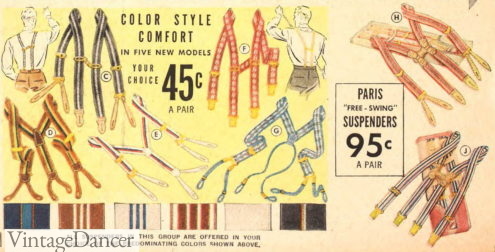
1938 web stripe suspenders
The variation of suspenders played with the backs. The classic was the English Y back suspenders but there were also cross back (X back), swing back (H back), cord back, ring back, swivel back, and clip back. Each style had its fan and followers.
Suspenders had leather straps that buttoned onto the inside of a trouser waistbands. There were clip on suspenders but they look less dressy and were prone to slipping off.
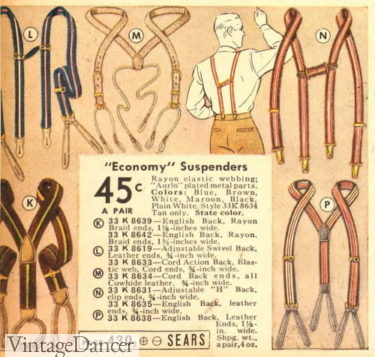
1938 suspenders
Suspenders for workwear were slightly wider and of a heavier webbing. Learn more.
Shop men’s vintage style suspenders. I don’t recommend purchasing vintage suspenders sunless you can see them in person. The elasticity has deteriorated out of most vintage belts from the 1930s.
1930s Men’s Belts
With casual outfits and sportscoats a belt was worn instead of suspenders. In summer, belts were also acceptable with formal suits without a vest.
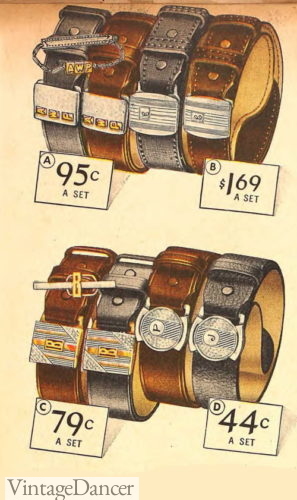
1938 men’s belts and buckles
There were four categories for men’s belts: leather belts with buckles, Garrison belts, Western belts, and sport belts.
Cowhide leather belts were about 1 3/8 inches wide in smooth or pebble grain brown, grey, navy blue or black leather. The belt buckle was a large silver rectangle or circle with initials, sport theme, or Art Deco design. There was also the classic prong style buckle with curved edges.
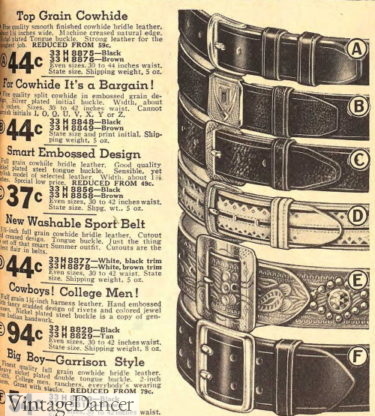
1935 prong buckle belts
Garrison Belts were wide 2 prong leather belts. Many uniformed professions wore the Garrison belt, such as Policemen.
Western Style Belts featured embossed leather, tooled scrollwork, and metal studs. They could have single prongs or double prongs.
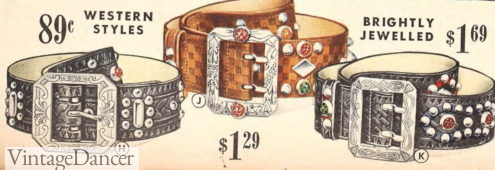
1937 studded western belts
Sport Belts were what men wore with their summer suits and casual outfits. White or ivory was the best colors in leather that was braided, pierced, whipstitched, or edged with cording. Some were two tones of two colored leathers. Some were pastels- pink, yellow or blue.
Cotton woven fabric belts were also a summer belt with colorful stripes or foulard prints. Both cotton and leather belts had silver, brass or white enameled buckles.

1937 men’s summer sport belts
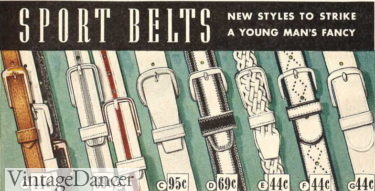
1939 men’s sport belts
The skinny 3/4 inch belt could be worn with the extra wide waistband “Hollywood” pants, although most young ment did not wear them with belts. The skinny belt fad would continue with college kids, boy teens and mature men in the 1940s.
Jewelry – Tie Chains and Clips
Read the History of Men’s Vintage Jewelry- Collar Bars, Rings, Tie Clips
Since the Victorian era men wore a standard set of jewelry comprising of tie clip, cuff links, and pocket watch on a chain. In the 1930s these basics were expanded to include key rings, collar clips, tie chains, lapel watch chains and money clips. Adding more jewelry was an affordable way to dress up a tired outfit as well as the illusion that “all was great” despite the Depression.
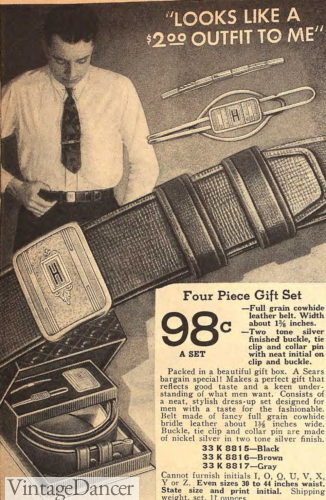
The tie chain draped across men’s ties which were now 3 1/25 to 4 inches wide. The chain was attached to a tie bar that slipped through a shirt buttonhole and behind the necktie. The chain held the tie down in the front. The placement of the bar and chain was usually mid chest around the 3rd button hole. It was unnecessary to wear a vest and tie chain since they did the same job of keeping a tie in place.
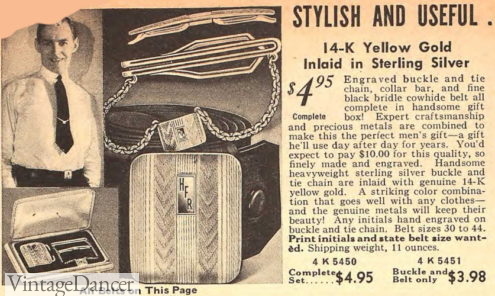
1938 position of tie chain
Tie chain bars were one bar or two connected prongs. They could have a small gemstone in the center or a sport figure. The chain held a monogram, initial, animal or sport motif in the center. This gave the wearer a visible taste of his interest and personality.
- 1938 men’s tie chain with matching belt buckle
- 1939 men’s belts, tie chains collar bars
The tie chain was a flashy accessory only worn by a handful of dapper dressers. The typical man preferred a tie clasp or tie bar instead. They grasped both shirt plaquette and tie together with a wider round or Dimond shaped bar on the backside. On the front could be a man’s initials but most often they were plain.

1938 men’s tie chains and tie clips
- 1938 initial tie bar in silver and gold with matching belt buckles
- Tie bar placement
Jewelry – Collar Bar
Collar bars were sold in gifts sets with tie chains and belt buckles. The wide Spearpoint collar was unruly and needed a collar bar, called a collar grip. The grip pinched each side of the collar and held it in together with the necktie knot over in the center of the bar.
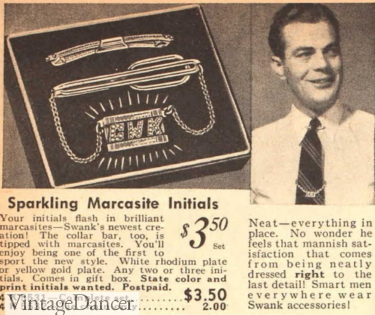
1938 men’s collar grip, tie chain, with placements
An earlier style of tie bar was the tie pin where a sharp pin pierced through the collar. They damaged collars and went out of fashion once collars were fused with cellulose, making them stiffer and easier to grip.
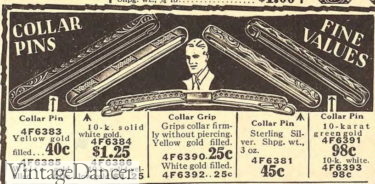
1931 collar pins
Collar bars could be intricately decorated with engravings or very plain.
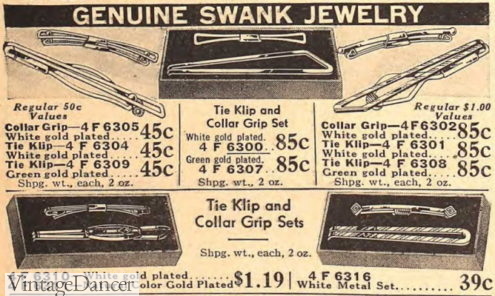
1934 mens collar grips, tie bars
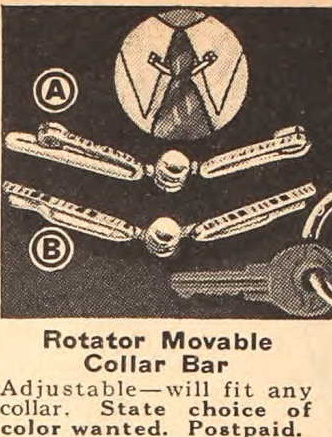
1938 rotator collar bar
Men’s Watches
Read the history of men’s watches here.
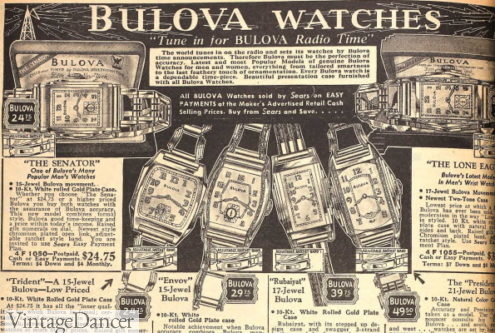
1934 Bulova men’s wrist watches
The new invention in the 1930s for men’s watches was the watch lapel guard. Gold chains, leather straps or braided leather cords affixed to a jacket button hole on one end and the pocket watch or strapless wristwatch on the other. The watch could then be dropped in the jacket breast pocket.
- 1933 pocket watch and braided leather fob
- 1937 wrist watch or fob
Another way to hold a pocket watch, key chain or pocket knife was with a belt clip. The belt clip slid through the belt with a chain that could attach to a pocket device. They were often sold with matching belt buckles.
- 1931 belt buckle and clip set
- 1931 belt buckle, belt clip and pocket knife set
The pocket knife (Swiss Army knife) was a very popular item for men to carry in their pockets, attached to a belt chain. A single or double knife blade with a nail file was a basic pocket knife. They were elaborately decorated in the early years followed by a minimal Initial and Art Deco designs in the later years.
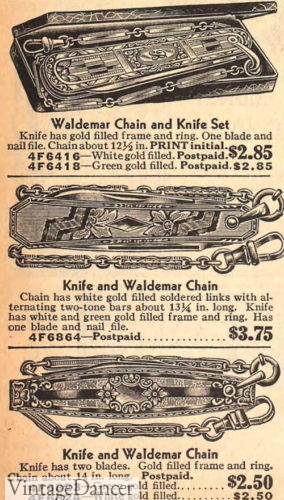
1931 knife and chain
The key ring was another accessory to attached to a belt chain. The horseshoe shaped ring attached to a chain and then the belt clip.
- 1936 gold belt clip and chain
- 1938 key chain
Jewelry – Cufflinks
Cuff Links closed up French cuff dress shirts in an elegant fashion. Considered an old accessory they gained new interest in the mid 1930s.
Round and squares faces set with colored stone were some of trendiest cuff links, especially set in yellow gold. Novelty designs could be initials, horses, sport hobbies, and simple balls.
In the early years, antique settings of flat gold faces with elaborate scrollwork looked very Victorian.
- 1936 men’s Swank cuff links
- 1938 mens Swank cuff links and jewelry
- 1931 gold filled cuff links
- 1931 small gemstones cuff links and tie clip
Jewelry -Rings
There were a few types of rings men might wear in the 1930s:
Birthstone rings – Featured large gemstone for his birth month. A gemstone ring not associated with a birth month could also be chosen for their beauty or school/club color.
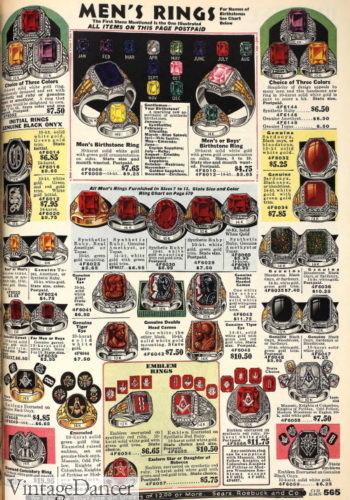
1931 men’s rings- many colorful gemstones
Initial Rings – Flat faced rings with a single Initial or monogram
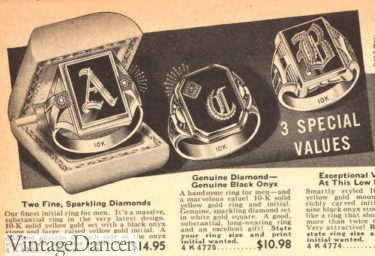
1938 men’s rings often featured an Initial
Masonic Rings – Symbols of one’s mason club or fraternity, usually gold and black.
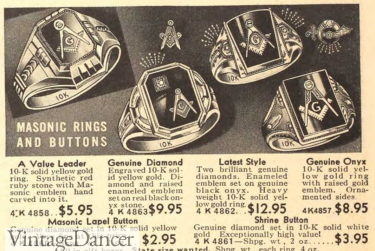
1938 Masonic rings
Tiger Eye Cameo Rings – A symbols of power and strength. These rings featured a cameo of Greek Warriors. Usually placed on the pinky finger.
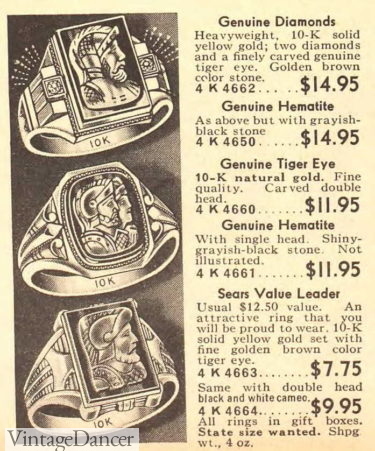
1938 Cameo Tigers Eye Ring
Wedding rings? It was uncommon for men to wear wedding rings in the 1930s. This would begin to change in the late 1930s. If a groom were to select a wedding ring it could match that of the bride. These could be feminine with flowers or neutral plain gold bands.
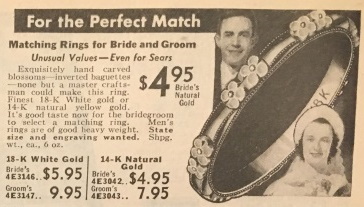
1938 matching wedding rings for bride and groom
Pocket Squares / Handkerchief
The pocket square handkerchief became a necessary accessory for men’s suits. Most pocket squares were silk foulards that often matched the tie, in color, if not also patterns. To wear a matching set was a good choice for every man expect the very well dressy who found the set to be too “pedestrian.”
- 1931 men’s handkerchief and tie set
- 1936 printed silk paisley pocket square
For the typical man, even dapper dressers, the white pocket square was perfectly acceptable.
The way to fold and place a pocket square was one of personal taste. The most common and easiest to fold was to pinch the center, fold in half, place down into the chest pocket and then pull out the tips to fill the entire pocket. This resulted in two or three points haphazardly peeking out the top.
- layered points
- Two points
In the 1930s men’s cologne makers encouragement gentleman to sprinkle the scent onto a pocket square (for the chest not trousers.) Scents of fern, heather, leather and wood spoke to the strong masculine sensibility.
For the white pocket square, placed into the trouser pocket or inside jacket pocket, there were solid white cotton or linen, with initials monogramed on one corner. Satin stripe edges and plaids were fancier handkerchiefs. The Bandana print, paisley, and colored ties were fun novelties.
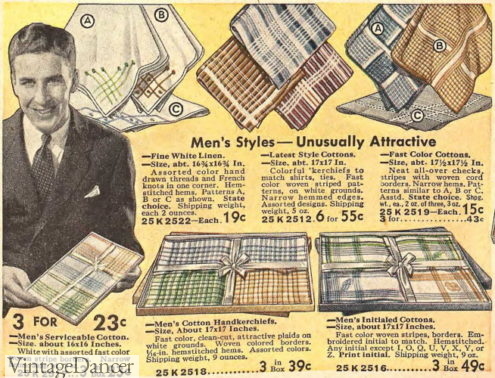
1935 men’ fancy handkerchiefs
Muffler and Scarves
The Bandana handkerchief crossed over into neck scarf or neckerchief classification when tied around the neck either in front like an ascot or into the back for Western cowboys and working classes.
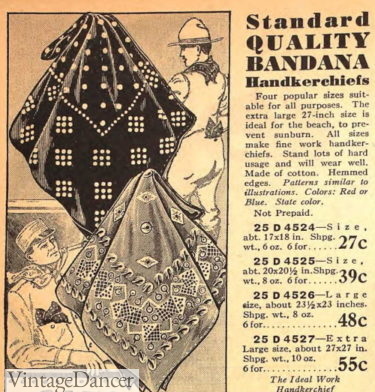
1933 bandana handkerchief scarf
A winter scarf or muffler was increasingly popular in the 1920s, reaching its peak in the 1930s. No longer strictly for winter warmth, the muffler was a fashionable accessory to drape around the neck and lapels of a topcoat or suit. In could be worn year-round in silks for spring and heavy wool for winter.
- 1931 mufflers, bandana scarves
- 1932 pocket squares, bandanas, and mufflers
The silk muffler was a thing of elegance. Foulard patterns, plaid, paisley, polka dots, diamonds, checks, zig zags and plain colors in jewel tones. In winter, the wool muffler was no less elegantly patterned. Short fringe edged the winter scarf.
For the vintage dancer, or any man needing an absorbent towel that looks like a scarf, purchase a BJ Dance Towel.
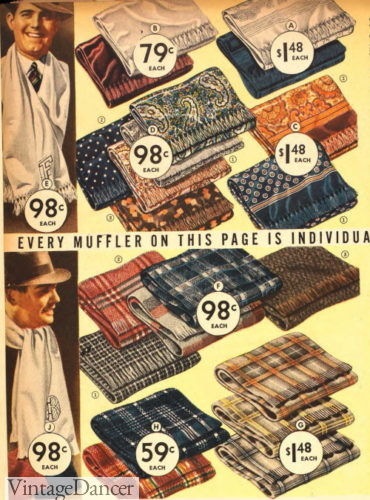
1938 wool mufflers
The monogram trend was carried onto scarves, especially white silk or wool knit scarves. These were often worn with formal evenings suits: tuxedos and dinner jackets. They were also worn with everyday suits, if they could be kept clean.
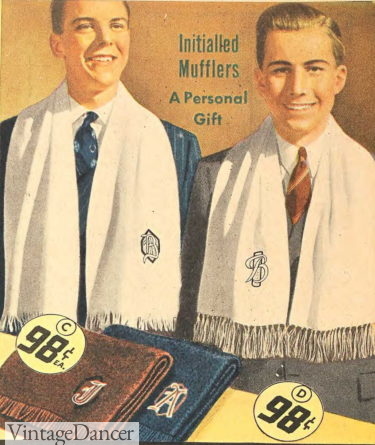
Gloves
Read about men’s 1930s gloves here.
Dapper men’s wore dress gloves with formal day suits but the majority of men did not. Only in winter did they pull out lined leather gloves with a snap or buckle wrist to keep hands warm.
- 1935 dress gloves- tan, brown, grey
- 1935 winter knit lined snap wrist gloves
Bags
If a man needed to carry books and papers he turned to a briefcase. Similar to a children’s book bag they were leather cases with two straps and a flap that buckled to one side.
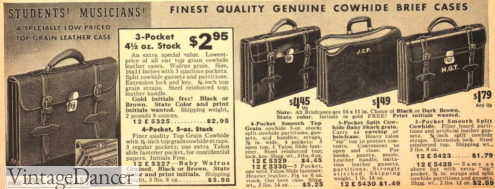
1937 men’s brief case bags
The satchel style briefcase lacked the two long straps and instead had two strong handles on top and a zipper opening.
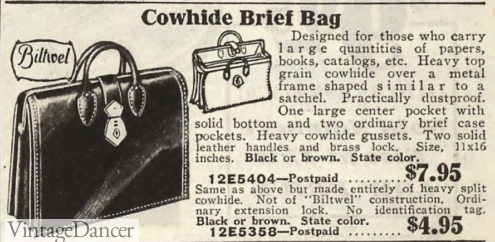
1931 satchel style brief bag
For general use such as day traveling, carrying sportswear (gym bag), camping, and other casual interest there were leather or cloth bags similar to the Doctor’s or Boston or Club bag of the previous decades. Made of wool tweed, cotton duck, or soft leather they had a zip top and two handles. The center stripe gave them the sporty look in the late 1930s.
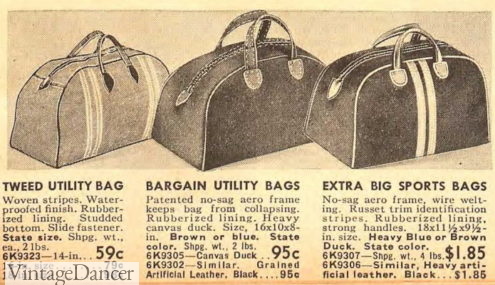
1938 all purses bags, sport bags, travel bags
The final bag you may see in 1930s men’s fashion illustrations is the leather binoculars bag. This small bag was designed to hold a pair of binoculars for watching horse races, bird watching, hunting, and surveying.
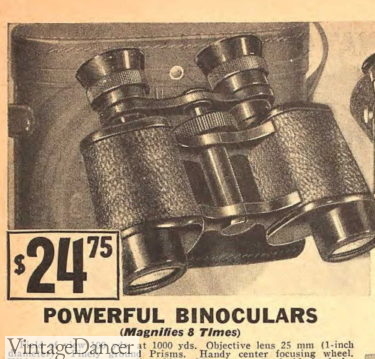
1935 binoculars and case
For more info about men’s bags and briefcases in the 1940s.
More Accessories? There were other accessories not included in this list, although these are the main ones. If you would like to know more about one be sure to ask me and I will keep adding to this list.
Debbie Sessions has been teaching fashion history and helping people dress for vintage themed events since 2009. She has turned a hobby into VintageDancer.com with hundreds of well researched articles and hand picked links to vintage inspired clothing online. She aims to make dressing accurately (or not) an affordable option for all. Oh, and she dances too.
